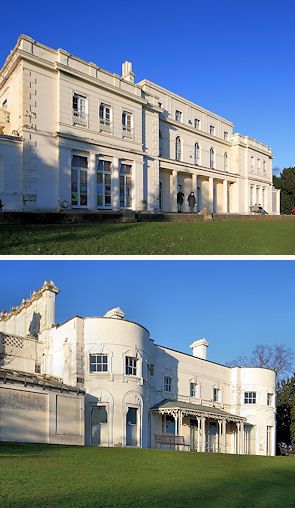|
|
 |
|
|
 |
A tube station, park and a pair of mansions situated in the far
north-western corner of Chiswick. Gunnersbury is one of the few places in London to have been named after a woman, in this
case Gunnhildr, whose manor this was. There is no evidence for the suggestion that she was a niece of King Canute but she
may have had Danish blood. Gunnersbury House was a Palladian mansion built in the mid-17th century for Sir John Maynard, the
king’s principal serjeant-at-law. Princess Amelia, daughter of George II, made the villa her summer residence from 1762
to 1786. The estate was sold in 1800 and the house was demolished and replaced by Gunnersbury Park and Gunnersbury House,
later called the Large Mansion and the Small Mansion. In 1835 Gunnersbury Park was acquired and then enlarged by the banker
Nathan Mayer Rothschild. His nephew Leopold de Rothschild bought Gunnersbury House in 1889 and put it to use as a guest house
for visitors to Gunnersbury Park, who included Edward VII. After Leopold’s death in 1917 the estate was split up. Part
was sold for building, while the local boroughs bought the mansions and 186 acres of parkland. The Large Mansion is home to
Gunnersbury Park Museum, which displays Ealing and Hounslow’s local history collections. The Small Mansion is mostly
in a state of disuse. Gunnersbury station (originally Brentford Road) was rebuilt in 1966 with an 18-storey office block above,
now occupied by the British Standards Institution. The Russian Orthodox Cathedral stands on Harvard Road, just south of the
station. It was built in 1998 in the traditional ‘Pskov’ style, with an onion-shaped dome painted in blue with
gold stars. Gunnersbury Triangle is a six-acre nature reserve on Bollo Lane, situated between railway lines. It has birch
and willow woodland with an attractive pond, marsh and meadow, but not much in the way of rare species.
Gunnersbury Park hosts one of London’s most popular summer
festivals, the London Mela – a one-day celebration of Asian culture with attendances that can approach 100,000 if the
weather is good.
|
 |
|
|
|
 |

|
| The large and small mansions in Gunnersbury Park, both of which are urgently in need of restoration |
|
 |
|
|
|
|
Postal
districts: W3; W4
Station: District Line and London Overground (North
London line) (zone 3)
Further reading: Ann Collett-White and James Collett-White, Gunnersbury
Park and the Rothschilds, Heritage Publications, 1993
Website:
Gunnerbsury Park mansions
Text and selected images are reproduced with the permission
of Chambers but may differ from the published versions
All content © 2005–2010
|
|
|
 |

